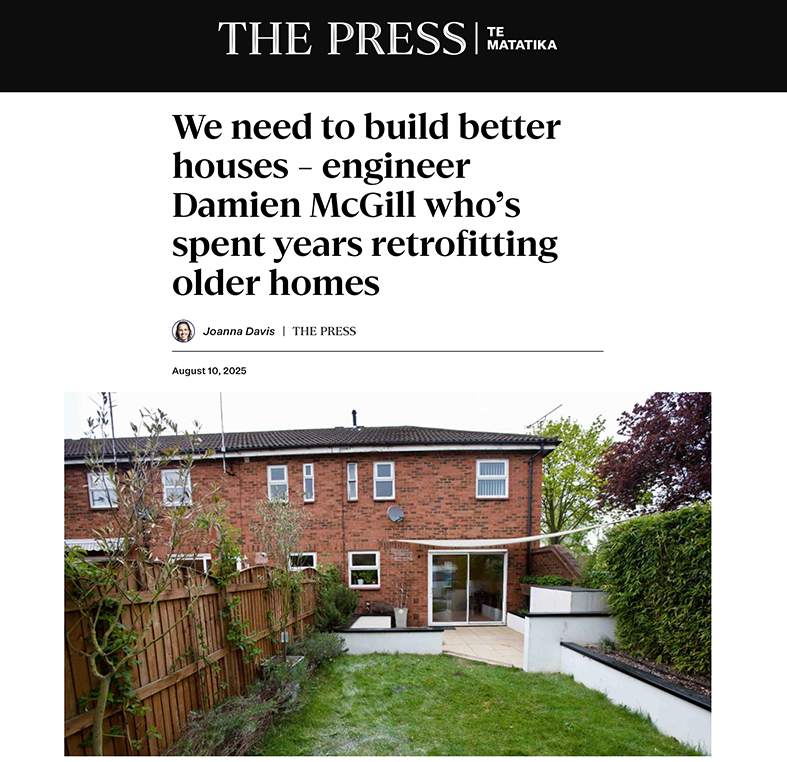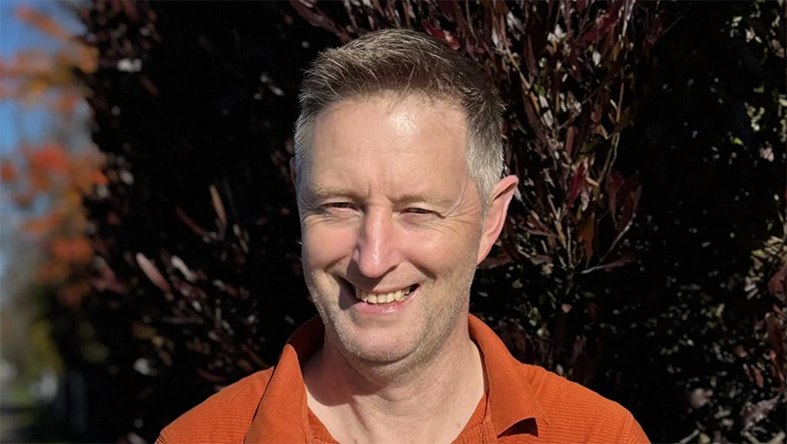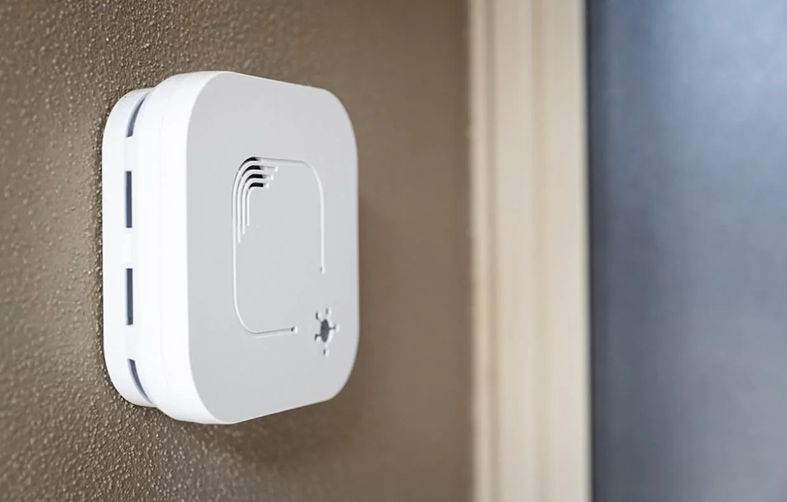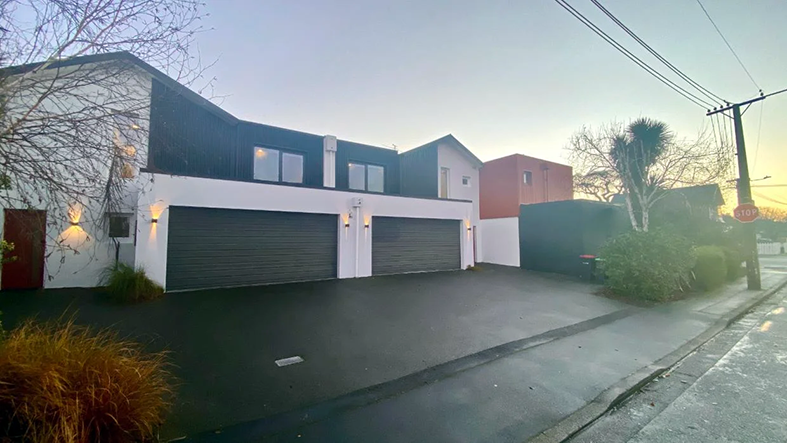
Damien McGill owns this property in Hertfordshire, England and - even from this distance - has done some energy-efficient/warm home upgrades including replacing the windows.
We need to build better houses - engineer Damien McGill who’s spent years retrofitting older homes
Joanna Davis
August 10, 2025
DAMIEN MCGILL
Engineer Damien McGill has such a passion for improving the standard of housing that he’s upgrading a property he owns 19,000km away, as well as some much closer to home.McGill, 52, the director of Healthy Home Cooperation, and his partner live in a townhouse in St Albans, Christchurch. They own the other two townhouses and have retrofitted all three to make them much more energy efficient.
What is your role, and what do you love about it?
DAMIEN: I love making a difference in people’s lives. Giving the gift of a happy healthy home for whānau to thrive, is one of the greatest gifts that can be given.
My business, the Healthy Home Cooperation, was founded during lockdown. It focuses on co-operating with like-minded people to provide housing advice through a practical engineering lens. This could be as simple as discussing heat pump operation or as complex as energy modelling, or geotechnical and structural engineering.

Healthy Homes engineer Damien McGill says he became an engineer so he could design his own house.
How did you get into this industry?
I’ve been interested in housing as far back as I can remember. I even became an engineer solely to design and build my own house. I’ve not acheived that goal, yet.
I studied the Passive House Consultants course in 2021 and am now a certified Passive House consultant and certified Passive House tradesperson.
I have a passion for what I do and am convinced it’s the only way forward. As an engineer, I can use critical thinking to understand and test theory and put it into practice in my own house or houses. I’m my own crash test dummy. I love to share what I learn with others. This is a way of reinforcing my learnings and improving my knowledge.
My volunteer role as chapter lead for Passive House Institute of New Zealand enables me to run monthly events around Canterbury to help to improve people’s building knowledge, including my own. My mission is to get everyone else on the same waka.

McGill owns three rental units on Manchester St in Christchurch and collects data to measure indoor and outdoor temperatures, humidity and carbon dioxide levels.
Where do you live?
I live in a three-bedroom townhouse just north of Bealey Avenue, in St Albans, Ōtautahi Christchurch. It is part of a 2003, three-unit development and my partner and I have acquired the other two units over the years.
We are three quarters through the renovation plan for the whole building. There has been a wee pause while we wait for interest rates to settle and build this business that pays for the necessary improvements to our own homes. We never intended to live near the central city, as we’re rural people at heart, but the convenience and lifestyle of inner city living is hard to beat.
For example, this weekend just gone, we walked into town to meet friends for lunch at Riverside Market and topped that off with a gelato at Rollickin Gelato, which is a favourite stop for me. On the sunny Sunday, we met more friends and walked into town for a Sunday roast, before walking this off around the Botanical Gardens and following the River Avon home.
It’s now becoming a hassle to get in the car to go somewhere. We’d both much prefer to walk!

Healthy Homes engineer Damien McGill has retro-clad and insulated these Christchurch townhouses, including the one on the left that he lives in.
What renovations have you carried out?
The aim is to create three of the warmest happiest rental properties in Ōtautahi.
We have:
Replaced double glazed aluminium with triple glazed PVC;
Overclad the direct fixed polystyrene plaster system with steel profile cladding where on timber frame to weather protect and retain the additional insulation. (Walls are twice the current building standard insulation requirement);
Installed continuous extract ventilation, while we psych up the courage turn each place inside out to retrofit mechanical ventilation with heat recovery (MVHR). This will provide tempered fresh air directly where it is needed and reduce CO2 levels around the house;
Added an extra R4 of wool insulation to the ceilings: This has reduced summer overheating considerably;
Insulated the top of the slab in one unit for warmer floors.
Work still to do includes moving the hot water cyclinders outside so the MVHR unit can go in the HWC space, and adding solar panels once we’ve replaced a section of flat roof, which will also give us an opportunity to add more insulation.
Where and when did you buy your first home?
I bought two houses next door to each other in Masterton, as a 23 year old, for $72,000 almost 30 years ago. They were transitional villas of 1920s vintage and hadn’t been altered since they were built. I worked three jobs to save the deposit and then pay for the renovations, which I did myself. I started with repiling, then insulating and draught-proofing them; floor, walls and roof.
I was trying to create a Healthy Home for us, before it was even a topic of conversation. I couldn’t solve the problem of the draughty double hung windows though. When I started, the house was so cold that even the mice had to do laps to keep warm. It’s not very romantic for a young couple, just starting out, when you have to go to bed with balaclavas on.
Part-way through the renovation we got the chance to go to the UK on our OE. From Masterton to London was a massive culture shock. There we discovered radiators and central heating; every room, the same comfortable temperature all the time, all year around. This was a revelation and a realisation that we don’t have to live the way we do in Aotearoa.
We house-shared in Clapham Junction to begin with, before moving to Welwyn Garden City in Hertfordshire where we rented until we bought an end-of-terrace house and began renovating that too. We have just added triple glazing to that house because the UK housing standards are not great either.
Coming back home 10 years later, I set about improving the standard of home we lived in and now this has expanded to include other homes too.
What do you think of Healthy Homes standards for rentals?
The Healthy (living room) Home standards are a poor target and insufficient to provide comfortable housing. Property investors should be providing decent accommodation to their clients at a much higher standard than the bare minimums set in this legislation.
Any last thoughts on New Zealand’s housing stock?
I used to love the older style of housing; villas and bungalows, but inspecting cold earthquake-damaged homes in the middle of winter put me off. It’s not healthy to be cold and miserable. You can’t thrive in a cold, damp, draughty, damaged hovel.
The quality of housing generally must improve, we need to start looking at whole-of-life costs, rather than purely upfront prices and profits.
The ultimate comfort standard is the international Passive House standard. This is where we will end up. The Ministry of Business Innovation and Employment has already recognised this. It’s just how long we take to get there due to the resistance of those who don’t like change, which will dictate how many tens of thousands of locked in problems we will have to fix when we do.
It’s always cheaper to do a proper job at the start, than to go back and fix substandard buildings later.
HEALTHY HOME COOPERATION
Healthy Homes for all Kiwis. Housing is about people. People working together in cooperation to provide Healthy Homes for people to live in.
Damien McGill: Engineering Happy Healthy Homes for People & Planet